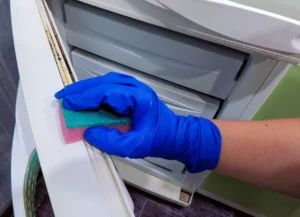
Many of us store food in our freezer that we plan to eat one day. It may be meat from an animal, a frozen birthday cake, or even this week’s dinner. Whatever the case may be, most homeowners use their freezers consistently. Can mold grow in a freezer? Yes, if there is excessive moisture, as well as a door seal that is damaged, food spill, or condensation.
Let’s learn more about mold growing in a freezer.
Does a Freezer Kill Mold?
While extreme cold temperatures can inhibit mold growth, they do not necessarily kill it. Mold spores can survive in freezing temperatures and may become active once the environment warms up. Therefore, simply placing moldy items in a freezer may not eliminate the mold problem.
Can Mold Grow in a Freezer?
Yes, mold can grow in a freezer. Moisture is the primary factor that promotes mold growth, and if there is excessive moisture present in the freezer, mold can thrive in this environment. This can occur due to various reasons, such as a damaged door seal, condensation buildup, or food spills.
What Causes Mold to Grow in a Freezer?
Several factors can contribute to mold growth in a freezer:
- Moisture: Excessive moisture or humidity inside the freezer can create an ideal breeding ground for mold.
- Damaged Door Seal: A faulty or damaged door seal can allow warm air from outside to enter the freezer, leading to condensation and increased moisture levels.
- Food Spills: Any food spills or leaks within the freezer can provide nutrients for mold growth.
- Lack of Ventilation: Poor ventilation can trap moisture inside the freezer, promoting mold development.
Tools You Need to Clean a Moldy Freezer
Before starting the cleaning process, gather the following supplies:
- Rubber gloves: Protect your hands from potentially harmful cleaning chemicals.
- Face Mask: Prevent inhalation of mold spores while cleaning.
- Cleaning solution: Use a mixture of water and mild detergent or a specialized mold cleaner. Check the label for instructions.
- Sponge or cloth: Wipe down the surfaces of the freezer.
- A toothbrush or small brush: Use this to clean hard-to-reach areas or stubborn mold spots.
- Bucket: For mixing the cleaning solution and collecting dirty water.
- Towels: Dry the interior of the freezer after cleaning.
How to Clean a Moldy Freezer?
- Prepare the freezer: Unplug the freezer and remove all items from inside. Dispose of any moldy or expired food items.
- Wear protective gear: Put on rubber gloves and a face mask before starting the cleaning process.
- Mix the cleaning solution: Prepare a mixture of water and mild detergent or a specialized mold cleaner in a bucket.
- Clean the interior: Dip a sponge or cloth into the cleaning solution and thoroughly wipe down all the surfaces inside the freezer. Pay extra attention to any visible mold spots.
- Scrub hard-to-reach areas: Use a toothbrush or small brush dipped in the cleaning solution to scrub away mold from tight corners or crevices.
- Rinse with clean water: Once you have removed all visible mold, rinse the interior of the freezer with clean water to remove any remaining cleaning solution.
- Dry the freezer: Use towels to dry the interior of the freezer completely.
- Plug in and restock: Plug the freezer back in and wait for it to reach the desired temperature before restocking it with food items.
Other Recommended Maintenance
Now that you know about mold growing in a freezer, let’s take a look at a few other areas of recommended maintenance. One of those is the size of the generator to run a freezer and refrigerator. Most people use a 2000-watt generator, but there are ones that are 3000-watt for standard refrigerators.
Another is if a refrigerator needs a dedicated circuit. It does need one to handle the amount of electricity and avoid electrocution.
Lastly, it is important to know what an electrical fire smells like. It smells like electronics, burning plastic, or rubber. If you smell this, it is a good idea to have the home inspected.
When to Call a Professional
In some cases, cleaning a moldy freezer may require professional assistance. Consider contacting a professional if:
- The mold growth is extensive and covers a large area.
- The mold has penetrated deep into the insulation or other inaccessible parts of the freezer.
- You have health concerns or allergies related to mold exposure.
Conclusion
While a freezer may not always kill mold, mold can grow in this environment. Excessive moisture, damaged door seals, food spills, and poor ventilation can all contribute to mold growth in a freezer. By following the proper cleaning procedures and using the necessary tools, you can effectively clean a moldy freezer. However, if the situation is severe or you have health concerns, it is best to seek professional assistance. While cleaning your refrigerator, you can call the Bentley Home Inspection team for a home inspection in East Tennessee and surrounding areas.





